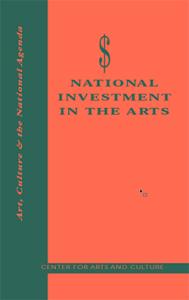
Author: Seaman, Bruce A.
Publication Year: 2002
Media Type: Report
Summary:
This issue paper, National Investment in the Arts, is the sixth in the Art, Culture and the National Agenda series. Written by Dr. Bruce A. Seaman from Georgia State University, National Investment in the Arts looks at the ways in which the public sector supports the arts in America through direct grantmaking, tax policies, and other public policies. This issue paper, like others in the series, reflects the opinions and research of its author, who was informed by commissioned background papers and the assistance of the Center’s Research Advisory Council. The paper does not necessarily represent the views of all those associated with the Center.
Abstract:
For more than a decade, discussions of the condition of the arts in America and the future of public arts policy have been tortured by the high decibel controversies surrounding the role of the National Endowment for the Arts (NEA). Such debates have occurred in the context of a longer historical experience that has stressed distinctions concerning economic support systems for the arts that tend to force people into opposing camps. Such traditional distinctions include: (1) private vs. public funding; (2) “earned” vs. “unearned” income; (3) public national vs. state vs. local funding that is endemic to the complex “division of labor” that characterizes a federal system; (4) for-profit vs. non-profit arts organizations; and (5) successful and financially wealthy producers of “popular” culture and mass entertainment vs. financially vulnerable producers of live, high quality, “real” art.
As the dust settles on the “NEA wars,” with the agency locked into a consensus political compromise whose most measurable manifestation is a budget seemingly set indefinitely (in “real,” not nominal, dollars) at approximately $100 million per year1 an even more fundamental “academic” consensus has slowly emerged that is both surprising and compelling. In simplified form, this new consensus is that these common, important, and useful distinctions have lost their power to adequately explain the realities of the arts sector in America, or to provide sufficient guidance regarding public arts policy. [Executive Summary, p. 5]
Arts & Intersections:
Categories: Legislation, Funding, Federal, Cultural Planning
ADDITIONAL BIBLIOGRAPHICAL INFORMATION
PUBLISHER INFORMATION
Name: Center for Arts and Culture
Website URL: http://www.AmericansForTheArts.org